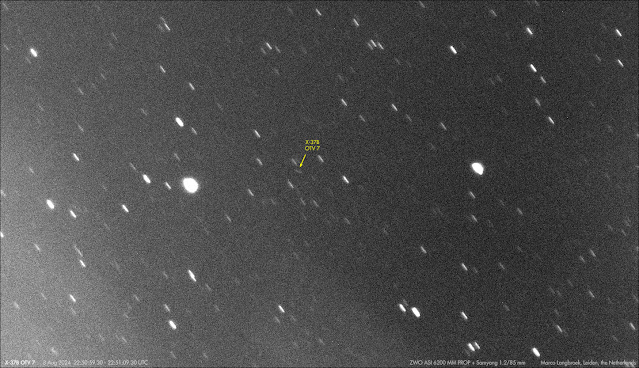 |
| OTV 7 imaged on August 11. Click image to enlarge |
In a previous blogpost I wrote about recovering the X-37B Spaceplane OTV 7 (2023-210A) on July 30. I have now observed it a couple of times, at intervals of a few days due to a combion of weather conditions and favourable or less-favourable pass times. Above is an image from August 11. The diagram below shows where it was in its orbital position at that time, coming down from apogee:
 |
| click image to enlarge |
Between mid-March and end-of-July, OTV 7 had brought down its apogee by a few thousand kilometers. Since recovery on July 30, it is continuously making smaller manoeuvers as well (currently, it seems to make small orbit raising manoeuvers adjusting both apogee and perigee). As a result, it is invariably off predictions (usually being a bit 'late') and a small plane scan is necessary to recover it. Having a wide-field instrument (the FOV of the instrument I currently use, an ASI 6200 MM PRO with 1.2/85 mm lens, is 24 x 16 degrees) is useful in this aspect.
The brightness of OTV 7 strongly depends on where it is located in its orbit during observation (as well as, of course, phase angle and condition of the local sky). When it is in or near apogee, it is fainter and the trail is short.
When following the object over (a part of) a pass, the brightness and apparent angular rate of movement (trail length) notably changes. How clearly it can be seen in the imagery is complex interaction of actual brightness, apparent angular movement (when it moves faster, each image pixel is illuminated less), range to the observer and phase angle.
Below are two images from the night of August 14-15, some 3 hours after OTV 7 passed apogee. The second of these images shows OTV 7 not far from M31, the Andromeda galaxy. Even though the two images are not at the same image scale (the one with M31 is reduced in size, to show a wider FOV), the difference in trail length after a mere half an hour can already be seen (both images are 10-second exposures with a ZWO ASI 6200 MM PRO and Samyang 1.2/85 mm lens).





